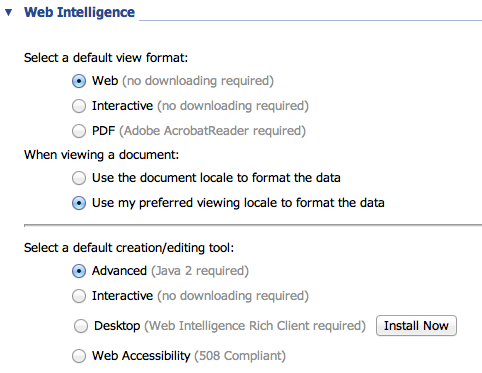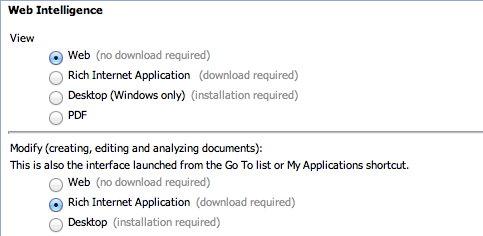Ever since the 2004 BusinessObjects roadmap described the eventual retirement of Desktop Intelligence, much attention has been paid to the feature gap between Desktop Intelligence and its successor Web Intelligence. Today, the feature gap is much more narrow than it was in Web Intelligence 6.0 or even Web Intelligence XI R1 or XI R2 (remember when lack of support for synchronized data providers was a big deal?). And Web Intelligence has evolved to contain exclusive features like input controls, advanced charting and mobility support. When Desktop Intelligence disappeared with the release of SAP BusinessObjects Business Intelligence 4.0 two years ago, concerns from long-term customers become more pronounced. The forthcoming Desktop Intelligence Compatibility Pack will debut later this year in BI 4.1 to address those concerns. And the current product roadmap will continue closing the Deski-to-Webi feature gap in BI 4.1 and BI 4.2.
But there is a second Web Intelligence feature gap that demands increasing attention, and that is the gap between the HTML (web) and Java-based (Rich Internet Application) versions of Web Intelligence. The best Web Intelligence experience has always required Java in the web browser and BI 4.0 is no exception. The web version continues to evolve but is always behind its more powerful Java-based relative.
Here are the preferences in the SAP BusinessObjects Enterprise XI 3.1 InfoView portal:

And here are similar preferences in the SAP BusinessObjects Business Intelligence 4.0 BI Launch Pad:
Despite the name changes from version to version, there’s always a Java and a non-Java version of Web Intelligence.
In BI 4.0, the following features are currently exclusive to the Java-based Rich Internet Application:
- Query support for BEx and Analysis Views
- Custom Cascading Style Sheets
- Custom number formats
- Conditional formatting
- Many usability features in the Java-based UI, including Data View
There’s also a third feature gap- Web Intelligence features like bullet graphs and scorecards that are only supported on the Mobile BI app- but I’ll discuss those in a future article.
Java on the desktop is becoming increasingly problematic for IT departments to update and support. Oracle halted support for Java 6 in February 2013 and SAP has only recently added support for Java 7 in its latest patches for SAP BusinessObjects Enterprise XI 3.1 and BI 4.0 (see related article The Future of Web Intelligence and Java on the EV Technologies blog). Apple has taken the drastic step of classifying older versions of Java 7 as malware (see related article Apple’s anti-malware blacklists Java 7 plug-in again on ZDNet). And the United States government, through its Department of Homeland Security, is recommending that “unless it is absolutely necessary to run Java in web browsers, disable it.” As of yesterday- and sure to be obsolete within nanoseconds- Oracle is providing Java 6 Update 43 (you know, the version they stopped patching last month?) and Java 7 Update 17 (see Oracle’s official Java SE Downloads page for the latest versions).
Ten years ago, it was impossible to create rich, engaging web applications without relying on plugins like Java or Adobe Flash. However, today’s modern browsers provide a different canvas for application developers to paint on. Tomorrow, on Wednesday, March 6, 2013, ASUG and SAP will present a webcast entitled What’s New in Web Intelligence 4.1. I hope that we’ll see that the roadmap for Web Intelligence leads to a Java-free future.
How is your organization coping with Java security woes?


Dallas:
What settings do you use or recommend when developing WEBI reports within BO 4.0? I too have many issue with Java. Great article!
—
Thomas
Thomas, I do not as of yet have preferred settings. I can tell you that one of our customers decided to use the non-Java Webi panel instead of Java for improved performance with BI4.
Dallas:
As in WEBI-Rich client (program installed on the client pc)?
Thanks
I must admit I’m not amused at 4.1 presenting us with new features that were standard in XI 3.1. Custom palettes, ability to run a single query in multi query document, ability ti edit merged dimensions,. Pretty shameless stuff…
James
Dallas, We identified several other parity issues with the web query panel, the biggest for our users is the lack of sub queries and data rankings. We have a lot of users pushing through and using it with quite a bit of success and only going to Java when those special cases, such as sub-queries comes around. We have an Idea on SAP’s Idea Place [BI 4.0 SP04 : DHTML Query Panel lacks parity to Java Query Panel], vote it up, or add more to it! Couldn’t hurt (not sure if it helps either!)
-Mark
Mark,
Thanks for writing. I was unaware that there was an idea in the Idea Place and will check it out. Was a bit surprised that the issue wasn’t addressed at all in a recent “What’s new in Web Intelligence 4.1” webcast, which I interpret “nothing new on the DHTML vs Java” front
Regards,
Dallas